Gallery Network
‘Nostalgia Is a Truly Winning Sentiment’: Artist Simon Fujiwara on How an Adorable Cartoon Bear Breathed New Life Into His Work
The Dadaist character takes center stage in Fujiwara's new show at Esther Schipper.
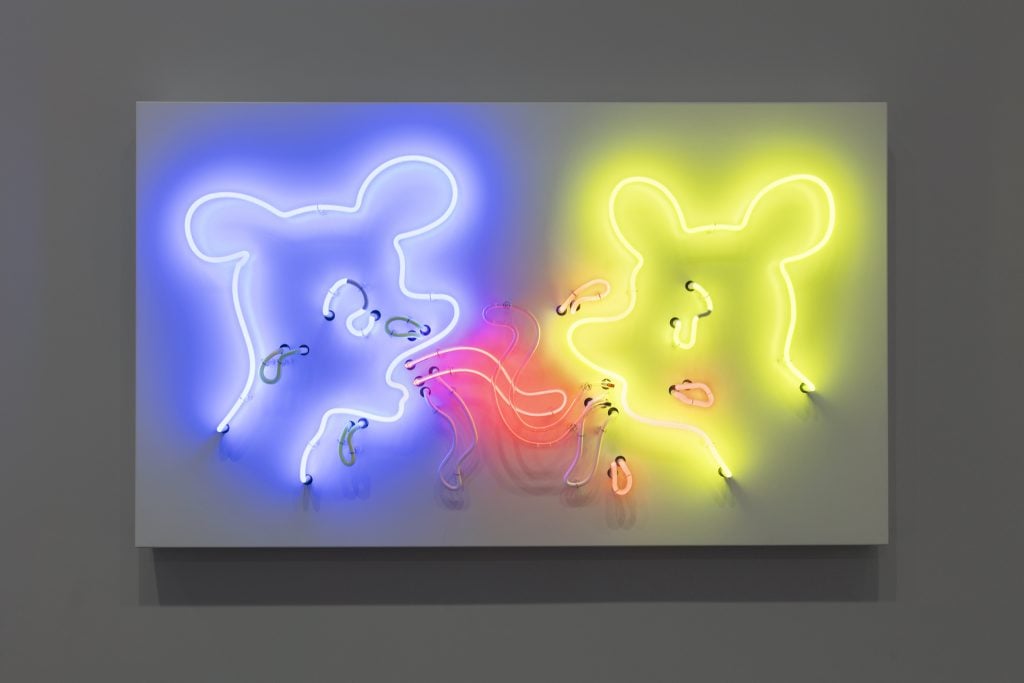
The Dadaist character takes center stage in Fujiwara's new show at Esther Schipper.

Katie White

You’ve heard of Winnie the Pooh, Rupert, and Paddington. Now, there is a new member of the fictional-bear pantheon: Who the Baer (yes, that spelling is intentional).
Who is Who, you ask? The cartoon is the creation of artist Simon Fujiwara—a character who travels Google and pops into various art-world images to try on different personas. Part of the series premiered at the Prada Foundation in 2020.
Now, Fujiwara is putting Who back in the spotlight with “Once Upon a Who?” the artist’s second solo exhibition at Esther Schipper in Berlin. The immersive show, filled with couches and with blue plush carpets, is designed to resemble a museum. Different rooms represent “chapters” filled with collage, drawing, sculpture, stop-motion animation, and even animatronic sculpture.
One room, called the “Whoseum,” showcases mock art-historical masterpieces from the Elgin marbles and ancient Egyptian sarcophagi to the works of Calder and Matisse. In each, Fujiwara has incorporated Who. The artist thinks of his bear as a Dada-like experiment; Who has no gender, race, sexuality, or nationality.
We recently spoke with the artist about his inspiration for the project and the potential that a fictional character affords an artist.
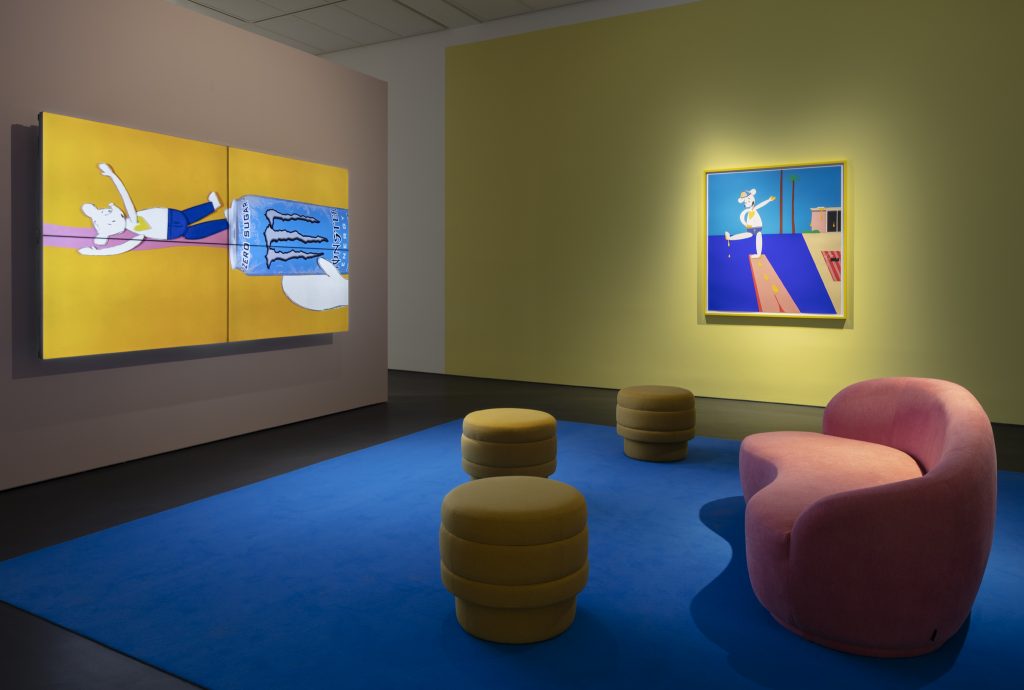
Installation view “Simon Fujiwara: Once Upon a Who?” 2022. Courtesy of Esther Schipper. Photograph by Andrea Rossetti.
Who the Baer is the central character in your new exhibition. Why did you decide to create them?
I liked the name Who the Baer because it reminded me of other famous cartoons like Pooh, and using a question like Who? as a name allows for all kinds of wordplay and confusion, which were very appealing to me. Because the world is so confusing and bizarre at the moment, I feel the only appropriate reaction is Dada in spirit—that’s to say, non-sensical. So, Who is a nobody, without an identity. Who circumnavigates the problem of identity politics—which has become one of the driving factors of our century—by not having an identity at all. Who is a proposition, a theory made flesh through hundreds of drawings, collages, and sculptures. But Who is really a fairy tale, in the end, one that asks “What if…?” and allows us to imagine things we are not really allowed to imagine or question at the moment.
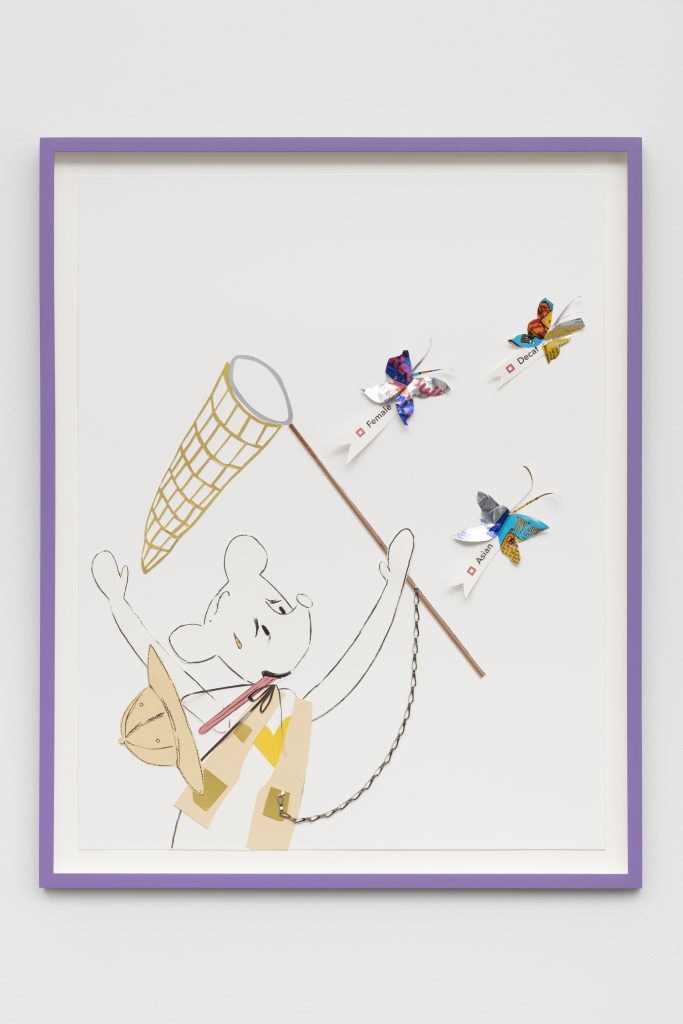
Simon Fujiwara, Who‘s Transformation? (Butterfly Catcher I) (2021). Courtesy of Esther Schipper. Photograph by Andrea Rossetti
I thought if we removed identity as a fixed category and turned it into a quest or a question, I could be playful with serious questions. So Who is a kind of cute void, an avatar, and a jester—a fool. They make the mistakes we don’t want to make, so we can pity them and feel generous toward them, and since they are full of longing and desire, they are attractive because that is energy. Humans are very attracted to energy, obviously, but they also love to be generous. There are just not many opportunities to feel generous. I think we underestimate how much we like to feel this emotion. That’s what appealed to me when I started to understand “Who is Who?”
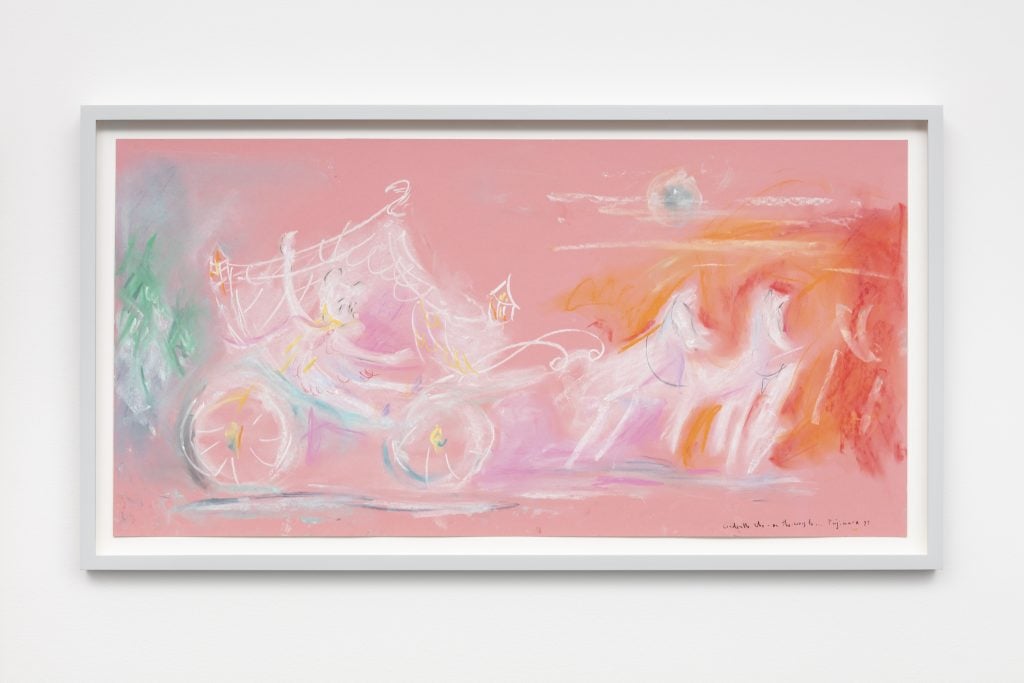
Simon Fujiwara, Cinderella Who on Their Way To…? (2022). Courtesy of Esther Schipper. Photograph by Andrea Rossetti
You’ve created this stop-motion animated video Once upon a Who. Can you tell me about making it on a technical level?
I am very hands-on with everything relating to Who the Baer, because I want the process and the work to be as directly “brain to hand” as possible so that there can be mistakes, detours, and wild cards thrown in that even I don’t anticipate. There is an urgency and spontaneity that comes through in the making. Who lends themselves to animation because they are a cartoon, but the labor in drawn animation would ruin the fun for me, so I decided to use the most basic of all techniques: stop-frame. Everything was cut in the studio and I animated the whole thing frame by frame. Although it looks very laborious, often I needed only one take to make a sequence. The medium is so forgiving because it is physical material.
The music and narration have a nostalgic quality.
The effect is one of hyper-nostalgia, which is very important to this work in general. There is a melancholy and nostalgia to all of the works and to the very concept of Who. Who is just an image, a vessel to accommodate other images, and all of those images as they pass through Who become effects, styles, and moods.
There seems to be no meaning to the images, just a performance that Who can take on. This evokes a kind of nostalgia for a time when meaning and aesthetics were codependent. Nostalgia has been a dirty word for a long time—it’s seen as the enemy of progress by the intelligentsia. Well, sorry, but nostalgia is a truly winning sentiment that drives most of pop culture! All pop songs today are a remix of some ’90s hit, politics runs on nostalgia, as does fashion in many ways. So I wanted to investigate this kind of radical nostalgia through this regressive character of a Dada-baby-world cartoon. It’s no wonder we want to look back or feel safe. Things are very unstable-feeling at the moment.
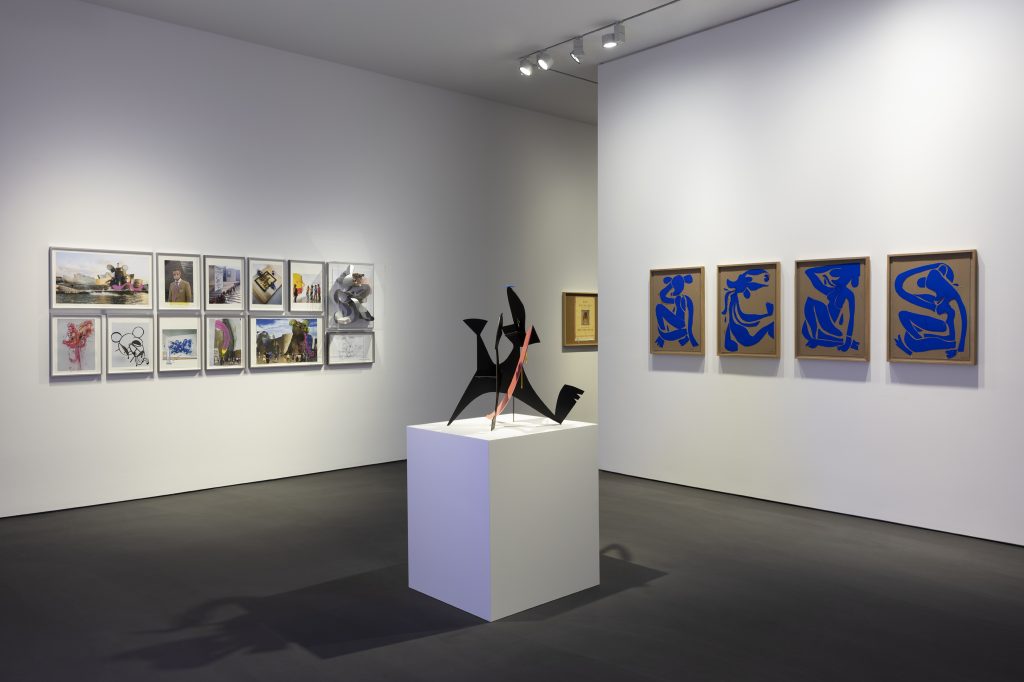
Installation view “Simon Fujiwara: Once Upon a Who?” 2022. Courtesy of Esther Schipper. Photograph by Andrea Rossetti.
In the “Whoseum,” Who’s features are overlaid on images of celebrities and art-historical masterpieces. Tell me about those images—we go from ancient Egypt to the Renaissance to Duchamp.
Who is like a search engine: they seem to consume all kinds of images, but they are not random. I can spot a “Who” image pretty fast. Normally there is some level of simplicity or what I call “iconicity” to it. Who is attracted to the most dominant, mainstream, and binary images because Who is just a cartoon, so naturally they seek out other cartoon imagery in the world.
I have been thinking about a theory of “the world as a cartoon” for a while. The idea is that as things like globalization, economics, and politics become more and more complex and impossible to grasp, we seek simplicity or icons to represent them. It’s a perverse counter-reaction, but not surprising. Our political leaders are cartoons, but so are our heroes; Greta Thunberg is a child icon tasked with the responsibility of representing global climate collapse, for example. We also seem to love brands and logos more and more in our fashion and the role of the masterpiece in art has not gone out of fashion.
So, Who sort of equalizes all of these icons, so that signs, symbols, humans, and brands all float in the same soup. In the Whoniverse, the Queen of England has the same status as Fifty Shades of Grey, a blue character from Avatar is as important as a Dürer rendering of Adam and Eve. The image serves Who for the effect it can have as a performative commodity.
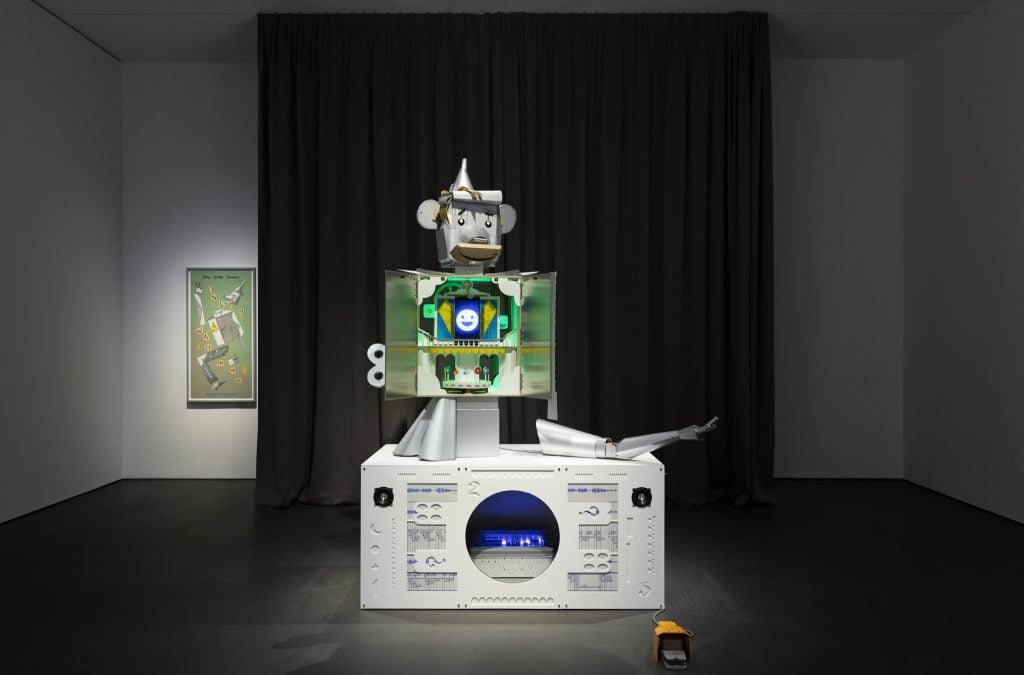
Installation view “Simon Fujiwara: Once Upon a Who?” 2022. Courtesy of Esther Schipper. Photograph by Andrea Rossetti.
Does authenticity matter?
We are pulled between the impossible poles offered to us at the moment, one narrative being, “You can be anyone, change anything, do anything and become anything!” and the other, “Find your authentic self—be your true, pure you that you find deep inside.”
It’s ridiculous and exhausting, but effective for marketing and keeping us dissatisfied. Who is not seeking authenticity and that is the pleasure Who can offer us, I believe. Who doesn’t suffer from the need to be real or authentic, so they have no friction, only desire and energy. I’m not sure if there is a lesson there, but it is something I enjoy witnessing, and for me, it’s a kind daily of practice when I draw. Through Who I say: don’t worry, authenticity is a phase that was invented and will also disappear. Don’t seek authenticity; seek energy, generosity, communication.
What are the benefits of working through a fictional character?
I used to hear writers say that their characters would speak to them, dictate the narratives, and I never understood how that is possible. But I do now. Who wants certain things, and Who can be certain things but not others. I’m as vain and eager to be loved as anyone else, but Who doesn’t let me rely on my crutches—trying to be clever or cool or skilled. When I am drawing a Who work, it has to feel like Who. Anything that looks too good goes in the trash, and I am quite “good” at drawing, unfortunately. Who helps me see what a good artwork looks like, and it’s about audacity, bravery, and simplicity. Dalí once said that you need to be a little bit stupid to be a good painter and that he is too intelligent to ever be brilliant as a painter. Who stops me from being a victim of my own intelligence. There is more to the body than the brain!
You’ve transformed the gallery bookstore into “The Whotique,” a boutique filled with Who-themed merchandise made in a collaboration with Highsnobiety. Why?
I had the idea that Who can operate outside the art world and speak to a larger public and, in some ways, act as an introduction to art as well as a way to discuss identity. I knew that I would need partners to make Who more accessible, to grow Who out of the museum. So I came up with the concept of the WHOTIQUE, an evolving store that pops up in real space and online, that sells Who the Baer merchandise and products. I have this fantasy that in ten years or so, there will be hundreds of Who products, and I can show them in a museum all laid out like evidence on a giant plinth as if coming full circle and bringing the lowest of commodities into the museum as a symbol of a time in history.
“Once Upon a Who” is on view at Esther Schipper, Berlin, through February 26, 2022.